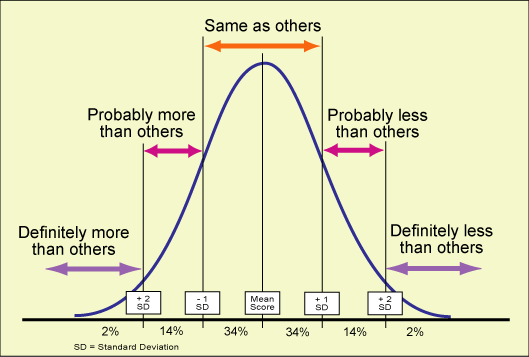- Descriptive Statistics: Summarizes and describes characteristics of a set of scores for a group
- Frequency Distribution: # of people who received each score
- Histogram: frequency distribution turned into a graph.
- The measure of central tendency: mean (average), median (middle), mode (most often)
- The measure of variability: provide info about the spread of scores (i.e range) (highest- lowest) least informative
Creating Deviate Score
Variance: distance between each store.
- Find the mean of all scores (M)
- Find how much each value deviates from that (X)
- Square all those values, making them all positive and ascertain a value (x^2) [Variance]
- Divide Variance by mean, then square root it to get the standard deviation
Normal Curve: symmetrical bell-shape curve that represent distribution in theory of the population.
SD can divide the curve into segments (68% of population fall within SD: -1-+1) (95% between SD: -2-+2 2% are above it) and nearly 100% between Sd: -3-+3 0.1% of being higher)
Based on the % of each segment allows us to predict the probability of an event transpiring. (through addition)
Psychologists TRY TO PREDICT WHY THESE EVENTS TRANSPIRE AND EXPLAIN THEM
Total variance= (variance account for by changing variable + variance not accounted for (random: error variance))
Applies to experiments and correlational studies
Pearson product-moment correlation coefficient: reflects direction/ strength of relation between two variables.
.5 coefficient DOES NOT mean that variables A and B and 50 percent related. SQUARE the r value to get the amount of variance that the two variables share or have in common. (.5^2=.25) 25% of A can account 25% of the data variance in B. REMEMBER CORRELATION IS NOT CAUSATION
If predicator variable is closest related to criterion variable then accurate prediction can be made
Factor Analysis: Take a large amount of correlations and makes small cluster, each containing highly-related correlations (uses computers
Can identify correlations between variables in a correlation matrix but can’t explain what those relations mean. Psychologists must do the rest.
Things that influence statistics:
1) Size of the difference (Big difference= more significant)
2) Variability of measure (More variability= less significant)
3) # of measurements (More measurement= more significance)
Inferential statistics: how confident are we in drawing conclusions/ inferences about population based on sample
The finding must be Statistically significant, meaning it didn’t happen by chance and was based on facts. Performing test multiple times will allow for a more accurate distribution
Null Hypothesis: any difference between sample data is due to chance



That was a very helpful, easy to read and conceptualise post~ thanks.